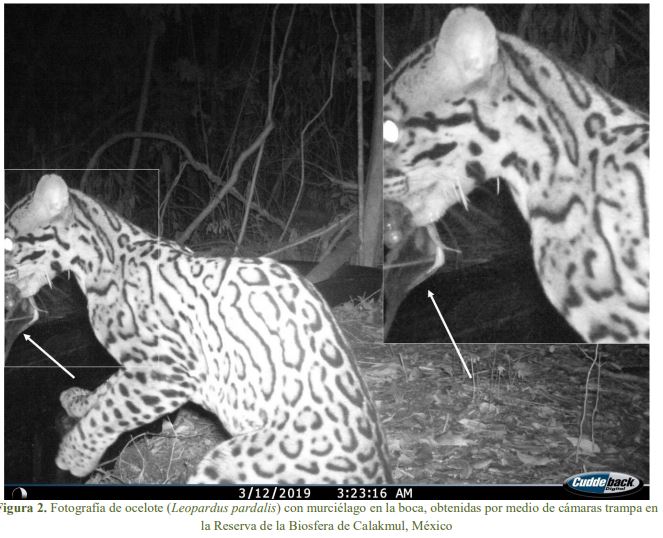Abstract
The ocelot faces conservation problems throughout its distribution, mainly due to illegal hunting and habitat transformation. It has been documented that the ocelot diet consists mainly of small nocturnal terrestrial mammals, especially rodents, although it has also been recorded that they can feed on possums, squirrels, rabbits, primates, iguanas, frogs, birds, fish, insects and terrestrial crabs.This note is relevant to the feeding behavior of ocelots in Mexico because it describes a photographic event of an ocelot feeding on a bat, the record was obtained with camera traps placed in the southern core zone of the Calakmul Biosphere Reserve. These cameras were installed to record that species of fauna visitrificiales drinkers (water sources constantly supplied by members of the project) that were placed as part of a pilot project in the years 2018 and 2019 and aim to supply water in the RBC for use of wildlife. As a result of this effort, this photographic record was obtained of an ocelot individual feeding on a bat associated with an artificial drinker.
References
Abreu, K. C., et al. 2008. Feeding habits of ocelot (Leopardus pardalis) in Southern Brazil. Mammalian Biology, 73: 407-411.
Bianchi, R. D. & S. L. Mendes. 2007. Ocelot (Leopardus pardalis) predation on primates in Caratinga Biological Station, southeast Brazil. American Journal of Primatology: 69: 1173-1178.
De Oliveira, T. G., et al. 2010. Ocelot ecology and its effect on the small-felid guild in the lowland neotropics. Biology and conservation of wild felids, 559-580.
De Villa-Meza, A., et al. 2002. Ocelot (Leopardus pardalis) Food habits in a tropical deciduous forest of Jalisco Mexico. The American midland naturalist, 148: 146-155
Di Bitetti, M. S., et al. 2008. Local and continental correlate of the abundance of a Neotropical cat, the ocelot (Leopardus pardalis). Journal of Tropical Ecology, 24: 189-200
García-Gil, G. & J. Pat. 2001. Apropiación del espacio y colonización de la selva en la Reserva de la Biosfera Calakmul, Campeche. Revista Méxicana del Caribe, 10:212-231.
IUCN (International Union for Conservation of Nature). 2020. IUCN Red list of threatened species, ver https://www.iucnredlist.org/es/species, última consulta: XV.I.2020
López-González, C. A., et al. 2003. The ocelot Leopardus pardalis in north–western Mexico: ecology, distribution and conservation status. Oryx, 37: 358-364.
Martínez, E. & C. Galindo-Leal. 2002. La vegetación de Calakmul, Campeche, México: clasificación, descripción y distribución. Boletín de la Sociedad Botánica de México, 71: 7-32.
Medellín, R. A., et al. 1997. Guía de identificación de los murciélagos de México. Comisión Nacional para el Conocimiento de la Biodiversidad. México.
Moreno, R., et al. 2006. Competitive release in diets of Ocelot (Leopardus pardalis) and Puma (Puma concolor) after Jaguar (Panthera onca) decline. Journal of Mammalogy, 87: 808-16.
Murray, J. L. & G. L Gardner. 1997. Leopardus pardalis. Mammalian species, 548: 1-10
Norma Oficial Mexicana. 2010. NOM-059-ECOL-2010, Protección ambiental-Especies nativas de México de flora y fauna silvestres-Categorías de riesgo y especificaciones para su inclusión, exclusión o cambio-Lista de especies en riesgo. Diario oficial de la federación
Nowell, K. & P. Jackson. 1996. Wild cats: status survey and conservation action plan. Cat Specialist Group, World Conservation Union/ Species Survival Commission, Gland, Switzerland.
Reid, F. A. 2009. A Field Guide to the Mammals of Central America and Southeast Mexico. 2nd ed. Oxford University Press, Nueva York.
Reyna-Hurtado. R., et al. 2019. Tapir population patterns under the disappearance of free-standing water. Therya, 10: 353-358.
Rocha-Mendes, F. & G.V. Biaconi. 2009. Opportunistic predatory behavior of margay, Leopardus wiedii (Schinz, 1821), in Brazil. Mammalia, 73: 151-2.
Sanderson, E., et al. 2002. Planning to save a species: the jaguar as a model. Conservation Biology, 16: 58-72.
Sunquist, M. E. & F. C. Sunquist. 2002. Wild cats of the World. Chicago: The University of Chicago Press.
Sunquist, M. E. & F. C. Sunquist. 2009. Family Felidae (cats), pp. 54-169, In: Wilson, D. E. & R. A. Mittermeier, (Eds.). Handbook of the Mammals of the World. Carnivores. Lynx Editions, Barcelona.
Tinoco, N. & A. Camacho. 2015. Records of bats predated by Leopardus pardalis (Carnivora: Felidae) in eastern Ecuador. Biodiversidad Neotropical, 5: 105-10.
Wang, E. 2002. Diets of ocelots (Leopardus pardalis), margays (L. wiedii), and oncillas (L. tigrinus) in the Atlantic rainforest in southeast Brazil. Studies on Neotropical Fauna and Environment, 37: 207-212.

This work is licensed under a Creative Commons Attribution-ShareAlike 4.0 International License.






